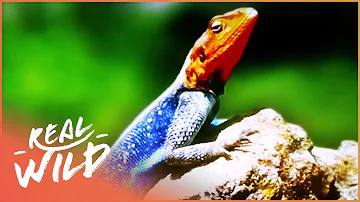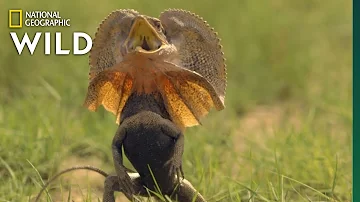
Basilisk Lizard
Basiliscus basiliscus

Meet the Basilisk Lizard
The Basilisk Lizard, often called the 'Jesus Christ Lizard', is a striking reptile native to the rainforests of Central and South America. It is famed for its ability to run across the surface of water for short distances, thanks to specialized fringes on its toes. This agile lizard is green or brownish with a distinctive crest on its head and back, especially prominent in males. Basilisk Lizards are diurnal and arboreal, spending much of their time in trees near water sources.
Classification
Reptile
Habitat
Tropical rainforest near rivers and streams
Diet
Omnivore
Lifespan
7-10 years
Conservation
Least Concern
Weight
200-600 grams
📖Fascinating Facts
Water-Running Ability
The Basilisk Lizard can run on the surface of water for up to 4.5 meters, escaping predators with this unique adaptation.
Arboreal Lifestyle
These lizards spend most of their time in the trees, quickly dropping into water when threatened.
Sexual Dimorphism
Males display larger crests on their head, back, and tail, which are used for attracting mates and intimidating rivals.
📋Detailed Description
The Basilisk Lizard (Basiliscus basiliscus) is a medium-sized iguanid reptile, typically reaching 60–75 cm (24–30 in) in total length, with males generally larger and more ornamented than females. Its most distinctive anatomical features include a prominent sagittal crest on the head, and additional crests along the back and tail, which are especially developed in adult males and play a role in sexual selection and display. The body is laterally compressed, aiding in swift movement through dense vegetation, and the long, muscular tail—comprising about 70% of its total length—provides balance during rapid locomotion. The skin is covered in fine, granular scales, and coloration ranges from bright green to olive-brown, often with lighter lateral stripes and darker markings for camouflage among foliage. Basilisks possess large, expressive eyes with round pupils, granting them excellent vision for detecting predators and prey. Their most famous adaptation is the ability to sprint bipedally across water surfaces, a feat enabled by elongated hind limbs, specialized toe fringes, and rapid, slapping strides. Diurnal and primarily arboreal, they are agile climbers and swimmers, frequently basking on branches overhanging water. When threatened, they can drop from trees and escape by running across water or diving below the surface, where they can remain submerged for up to 30 minutes. This species is omnivorous, feeding on a variety of insects, small vertebrates, fruits, and flowers, and plays a significant ecological role as both predator and prey in riparian rainforest ecosystems.
💡 Did you know?
The Basilisk Lizard can remain submerged underwater for up to 30 minutes to escape predators.
🔬Research & Sources
🎭Behavior & Social Structure
Basilisk Lizards are solitary and territorial, with males defending prime basking and feeding sites along riverbanks and streams. They are most active during the early morning and late afternoon, spending midday hours basking to regulate body temperature. Their foraging behavior is opportunistic; they hunt insects, spiders, small fish, amphibians, and occasionally small birds or mammals, supplementing their diet with plant matter such as fruits, seeds, and flowers. Basilisks rely on their acute vision and rapid reflexes to capture prey, often ambushing from perches or foraging along the forest floor. Social interactions are generally limited to mating encounters and territorial disputes, which involve visual displays—such as head-bobbing, dewlap extension, and crest erection—rather than physical combat. When threatened, they exhibit a freeze response before fleeing, utilizing their water-running ability as a primary escape strategy. Juveniles are more gregarious and may be seen in small groups, but adults are typically solitary outside the breeding season.
👶Reproduction & Life Cycle
Basiliscus basiliscus exhibits a polygynous mating system, with dominant males courting multiple females within their territory. Breeding occurs throughout the wet season, typically from March to September, when food resources are abundant. Courtship involves elaborate displays, including head-bobbing, crest extension, and circling. After mating, females lay clutches of 10–20 eggs in shallow nests dug into moist, sandy soil near water. Incubation lasts approximately 8–10 weeks, depending on temperature and humidity. There is no parental care after egg-laying; hatchlings are fully independent and capable of running and swimming immediately. Females may lay several clutches per season, with intervals of 4–6 weeks between clutches. Sexual maturity is reached at around 18–24 months, with growth rates influenced by environmental conditions and food availability.
🛡️Adaptations & Survival
The Basilisk Lizard's most remarkable adaptation is its ability to run across water, facilitated by long hind limbs, laterally compressed toes with specialized fringes, and a rapid, slapping gait that generates lift and minimizes sinking. This adaptation allows for quick escape from predators and efficient movement between habitats. Their cryptic coloration and patterning provide camouflage among foliage and dappled sunlight, reducing predation risk. The crests on the head, back, and tail serve both as sexual signals and as a means to appear larger to rivals or predators. Basilisks are excellent swimmers and can remain submerged for extended periods by slowing their metabolism and absorbing oxygen through the skin to a limited extent. Their omnivorous diet and flexible foraging strategies enable them to exploit a wide range of food resources, contributing to their ecological success in dynamic rainforest environments.
📚Research Sources
🎨Cultural Significance
The Basilisk Lizard is popularly known as the 'Jesus Christ Lizard' due to its ability to run on water, a trait that has inspired fascination and myth in local and global cultures. In Central American folklore, basilisks are sometimes associated with supernatural abilities or considered omens, though they are not typically hunted or used in traditional medicine. The species is a frequent subject in nature documentaries and ecotourism, symbolizing the extraordinary adaptations of rainforest wildlife. Its unique locomotion has made it an icon in popular science and educational materials, contributing to public interest in tropical biodiversity.
🔬Recent Research & Discoveries
Recent research has focused on the biomechanics of water-running in Basiliscus basiliscus, revealing that their stride frequency, toe surface area, and limb kinematics are finely tuned to maximize lift and minimize drag. Studies using high-speed videography and force measurements have provided insights into the evolutionary convergence of water-running in lizards. Genetic analyses have clarified relationships within the genus Basiliscus and highlighted the role of sexual selection in crest development. Ongoing ecological studies are examining the impacts of habitat fragmentation on population genetics and dispersal. Additionally, research into their thermal ecology is shedding light on how climate variability affects activity patterns and reproductive success.
🎥Wildlife Videos

Wildlife Instincts: Survival Techniques - Iguana vs. Basilisk | Free Documentary Nature
Wildlife Instincts - Episode 2: Survival Techniques - Iguana vs Basilisk | Free Documentary Nature Watch "Wildlife Instincts: The ...
Free Documentary - Nature

Wildlife - Just Reptiles | Free Documentary Nature
Wildlife - Episode 3: Just Reptiles | Wildlife Documentary Watch 'Wildlife - Episode 4' here: https://youtu.be/SNRyvGzDsww ...
Free Documentary - Nature

Jesus Christ Lizard | National Geographic
About National Geographic: National Geographic is the world's premium destination for science, exploration, and adventure.
National Geographic

The Strange World Of Lizards (Wildlife Documentary) | Wild About | Real Wild
Lizards are some of the world's most fascinating creatures. Join us as we learn all about these strange creatures and learn how ...
Real Wild

Australia’s Remarkable Reptiles - Lizards of Oz | Full Documentary
Australia is the driest inhabited continent on the planet with much of the inland being a virtual desert. However, cold blooded ...
Free High-Quality Documentaries

Frill-Necked Lizard Escapes Python | Wild Monsoon
About Wild Monsoon: Actor Colin Salmon narrates this program that takes a look at how monsoon winds have shaped the wildlife ...
Nat Geo Animals
🌍Habitat Information
The Basilisk Lizard typically inhabits Tropical rainforest near rivers and streams environments. Basilisk Lizards have adapted to their environments with specialized features and behaviors.
Primary Habitat:
Tropical rainforest near rivers and streams
More detailed habitat information will be available soon.
🛡️Conservation Status
The Basilisk Lizard is currently classified as Least Concern. Conservation efforts are crucial for preserving this species for future generations.
Common Threats:
- 🏠Habitat loss and fragmentation
- 🌡️Climate change impacts
- 🎯Hunting and poaching
- 🏭Human-wildlife conflict
⚠️Threats & Conservation Challenges
While currently classified as Least Concern by the IUCN, Basiliscus basiliscus faces localized threats from habitat destruction due to deforestation, agricultural expansion, and urbanization, which reduce suitable riparian habitats. Collection for the pet trade poses a minor but increasing risk in some areas. Predation by birds of prey, snakes, and mammals is a natural challenge, particularly for juveniles. Climate change may impact reproductive timing and habitat availability, though the species' broad range and ecological flexibility provide some resilience. Population trends are generally stable, but continued monitoring is recommended, especially in regions experiencing rapid environmental change.
🔬Scientific Classification
Scientific Name
Basiliscus basiliscus
Classification Hierarchy
🔍 About Taxonomic Classification
Taxonomic classification is a hierarchical system used by scientists to classify and organize living organisms based on shared characteristics and evolutionary relationships.
The system moves from broad categories (Kingdom) to increasingly specific ones, with each animal's scientific name typically consisting of its Genus and species.
📝Community Notes
Share your observations and insights about the Basilisk Lizard with our community of wildlife enthusiasts.
Join Our Community
Sign in to share your observations and connect with fellow wildlife enthusiasts.
Sign In to ContributeNo community notes yet
Be the first to share your observations about the Basilisk Lizard!
Explore Basilisk Lizard
Select a tab above to learn more about this amazing animal.
📸Photo Gallery
No photos available for this animal yet.
🌟Discover More Wildlife
Continue your journey of discovery with more fascinating animals from our database
